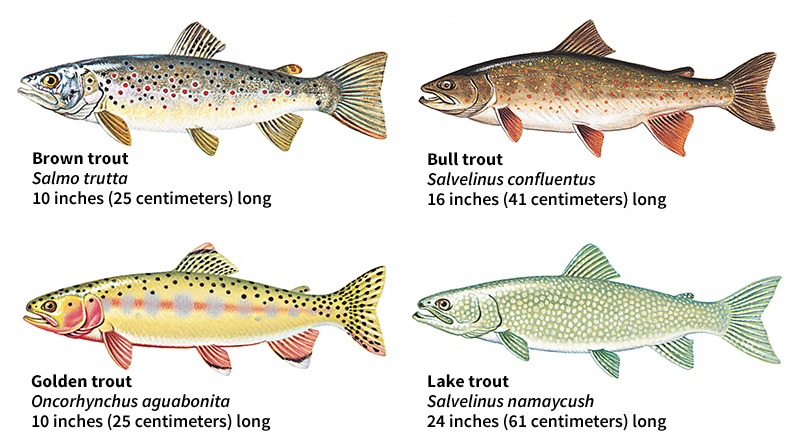Trout is one of the most important food and sport fishes. Trout are native to cool waters of the Northern Hemisphere. They have been introduced to cool waters throughout the world. Most species of trout spend their entire lives in freshwater streams and lakes. Some species migrate to the ocean to feed and grow. But they return to fresh water to spawn (lay eggs).
Kinds of trout
About 10 species of fish in North America are commonly called trout. All trout have strong teeth and streamlined bodies with small scales. A small, fleshy fin called an adipose fin grows on the back near the tail fin. Atlantic trout belong to the fish genus (group) Salmo. The genus also includes Atlantic salmon. Pacific trout belong to the genus Oncorhynchus. The genus also includes Pacific salmon. The trout in these two genera are considered true trout. Other trout belong to the genus Salvelinus, which also includes chars.

True trout
have dark spots on their bodies. The best-known species is the rainbow trout. This fish is native to western North America. It has been introduced to many other areas. It has black spots on the upper body and the tail. A brilliant reddish band extends along each side. Some rainbow trout, called steelhead, live in the ocean or large freshwater lakes. They return to inland streams to spawn. These fish are a steely-blue color.
Several species of true trout live only in waters of western North America. The cutthroat trout ranges from Alaska to California and from Canada to New Mexico. It gets its name from a red-orange slash on each side of the lower jaw. Other Western species include the golden trout of the California mountains, the Apache trout of Arizona, and the Gila trout of Arizona and New Mexico.

The brown trout has been introduced throughout North America. It is native to Europe and western Asia. Its body has dark brown or black spots. Many of the spots are surrounded by pale halos. The tail is only slightly forked. This trout may have red or orange spots, surrounded by pale halos, along the sides of the body.
Other trout
include the brook trout, the bull trout, and the lake trout. These fish have light red, pink, or cream-colored spots. The front edge of the lower fins is white. The brook trout has dark, wavy lines or blotches on the upper fins and tail. It originally was found only in streams in eastern North America. The bull trout lives in waters of the Pacific Northwest. The lake trout inhabits deep lakes and rivers in northern North America. It has a gray-green body and a deeply forked tail. Lake trout are the largest species of trout. A lake trout measuring 4 feet 2 inches (1.27 meters) long and weighing 102 pounds (46.3 kilograms) was taken from Lake Athabasca in Saskatchewan, Canada. It is the largest trout ever caught.
The life of a trout
Most trout spawn in streams or rivers. Others spawn in lakes with gravel bottoms and good water flow. Trout spawn in spring or autumn.
The spawning behavior of rainbow trout is typical of that of other trout species. In early spring, rainbow trout move upstream to a spawning area. The female chooses a suitable site. She often picks a shallow, gravel area at the beginning of a stretch of choppy water. There, the female turns on her side and beats her tail up and down. This motion scoops out a shallow nest called a redd. After the redd is prepared, the female positions herself over it. The male courts her by swimming alongside her and quivering his body. When the female is ready to spawn, she moves to the bottom of the redd and presses her belly against the gravel. The male positions himself close to her. As the female releases eggs, the male releases sperm that fertilize the eggs.
After the eggs have been fertilized, the female covers them with gravel. The eggs usually hatch in about 2 months. After the young hatch, they move up through the gravel into the water.
Young trout eat mainly invertebrates (animals without backbones), including insects. Mature trout also feed on other fish and on crayfish. They occasionally eat young birds, lizards, or other animals that fall into the water. The life span varies among species. Rainbow trout live up to 11 years. Lake trout live at least 25 years.
Trout fishing
All trout species are valued as sport fish. The rainbow trout and the cutthroat trout are prized because of their fighting ability and their spectacular leaps when hooked. The brook trout, another spirited fighter, also is a favorite among fishing enthusiasts. Lake trout are usually taken by trolling (trailing a line behind a boat) or by dropping a line through the ice in winter.
Some species are important commercially as food. Each year, commercial fishing crews catch great numbers of lake trout and steelhead. Rainbow trout and brook trout are raised in hatcheries and sold for food.
